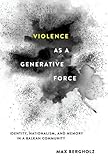Violence as a Generative Force.
Material type: TextPublication details: Cornell University Press, (c)2016.Description: 1 online resourceContent type:
TextPublication details: Cornell University Press, (c)2016.Description: 1 online resourceContent type: - text
- computer
- online resource
- 9781501705885
- Massacres -- Bosnia and Herzegovina -- Kulen Vakuf -- History
- Ethnic conflict -- Bosnia and Herzegovina -- Kulen Vakuf -- History
- Violence -- Bosnia and Herzegovina -- Kulen Vakuf -- History
- Nationalism and collective memory -- Bosnia and Herzegovina -- Kulen Vakuf -- History
- Communalism -- Bosnia and Herzegovina -- Kulen Vakuf -- History
- World War, 1939-1945 -- Bosnia and Herzegovina
- DR1785 .V565 2016
- COPYRIGHT NOT covered - Click this link to request copyright permission: https://lib.ciu.edu/copyright-request-form
| Item type | Current library | Collection | Call number | URL | Status | Date due | Barcode | |
|---|---|---|---|---|---|---|---|---|
 Online Book (LOGIN USING YOUR MY CIU LOGIN AND PASSWORD)
Online Book (LOGIN USING YOUR MY CIU LOGIN AND PASSWORD)
|
G. Allen Fleece Library ONLINE | Non-fiction | DR1785 (Browse shelf(Opens below)) | Link to resource | Available | ocn962413052 |
Includes bibliographies and index.
Vocabularies of community -- A world upended -- Killing and rescue -- Rebellion and revenge -- The challenge of restraint -- Forty-eight hours -- Sudden nationhood.
"During two terrifying days and nights in early September 1941, the lives of nearly two thousand men, women, and children were taken savagely by their neighbors in Kulen Vakuf, a small rural community straddling today's border between northwest Bosnia and Croatia. This frenzy--in which victims were butchered with farm tools, drowned in rivers, and thrown into deep vertical caves--was the culmination of a chain of local massacres that began earlier in the summer. In Violence as a Generative Force, Max Bergholz tells the story of the sudden and perplexing descent of this once peaceful multiethnic community into extreme violence. This deeply researched microhistory provides provocative insights to questions of global significance: What causes intercommunal violence? How does such violence between neighbors affect their identities and relations? Contrary to a widely held view that sees nationalism leading to violence, Bergholz reveals how the upheavals wrought by local killing actually created dramatically new perceptions of ethnicity--of oneself, supposed "brothers," and those perceived as "others." As a consequence, the violence forged new communities, new forms and configurations of power, and new practices of nationalism"--
COPYRIGHT NOT covered - Click this link to request copyright permission:
There are no comments on this title.
